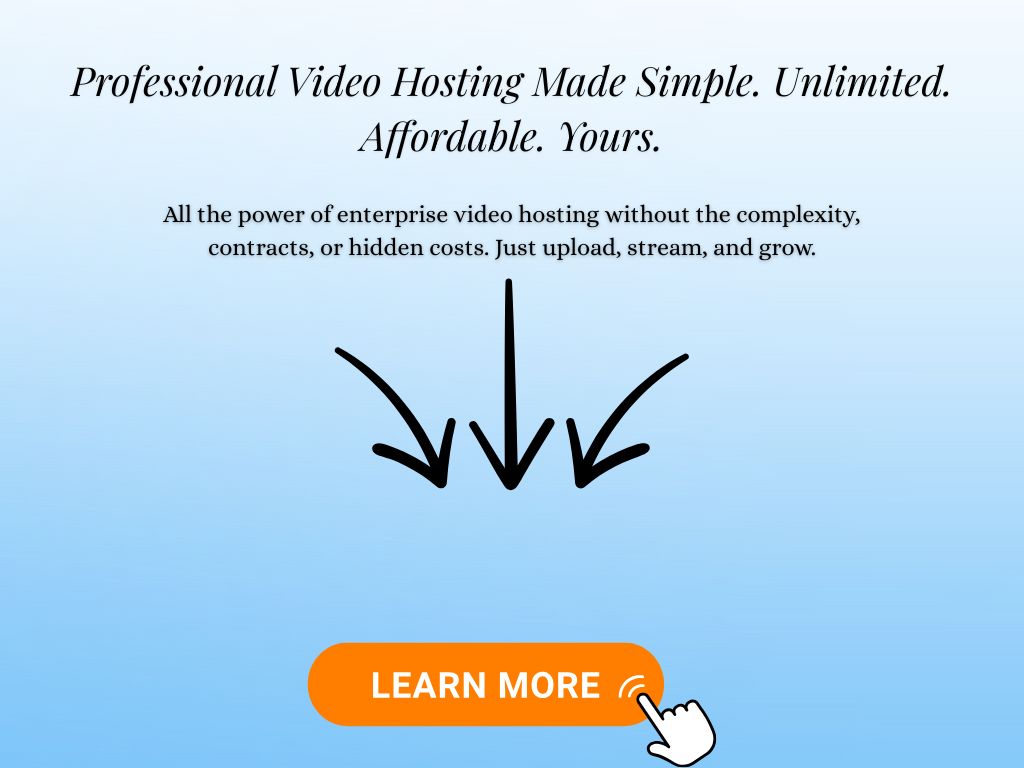Introduction
You spend hours creating videos that represent your brand but if they buffer, lag, or start with someone else’s ad, your message loses impact before it even begins. Viewers click away, credibility drops, and conversion opportunities vanish.
The problem isn’t your content. It’s your hosting.
In 2025, video isn’t an accessory. It’s the front line of marketing, sales, and trust. Yet too many brands still rely on free, ad-driven platforms that trade control for exposure. Every pre-roll ad, every delayed load, and every competitor suggestion erodes your authority and your results.
True video hosting gives you ownership of performance, analytics, and brand presentation. It ensures that every second of playback builds recognition, strengthens connection, and drives measurable growth.
In this guide, you’ll learn what separates professional video hosting from free alternatives, how to evaluate the right platform for your goals, and how to make every video an extension of your brand’s quality.
Key Takeaways
Why Choosing the Right Video Hosting Platform Matters
- Video hosting gives businesses control over playback, branding, and analytics, not just a place to store videos.
- Free platforms trade ownership and viewer trust for exposure and ads.
- Choosing the right host depends on your purpose: visibility, conversions, or scale.
- Professional hosting platforms improve load speed, reliability, and viewer engagement.
- Key features to prioritize include global CDN coverage, white-label players, analytics, and data privacy.
- Optimized hosting turns video from a content asset into a measurable growth channel.
- The right platform protects your brand, strengthens performance, and builds long-term credibility.
Disclaimer: I am an independent Affiliate. The opinions expressed here are my own and are not official statements. If you follow a link and make a purchase, I may earn a commission.

Why Video Hosting Matters in 2025
Video isn’t just a medium in 2025 it’s a brand experience. The way your videos load, play, and feel shapes how customers perceive your business before they read a single headline or click a single button.
That experience doesn’t depend solely on production quality. It depends on where your videos live.
Even the most polished, high-budget video loses its power when it:
- Takes a few seconds too long to start.
- Plays with ads that compete for attention.
- Displays someone else’s watermark instead of your logo.
- Freezes mid-play on mobile.
Every one of those moments chips away at trust and conversion. Hosting isn’t a technical detail, it’s part of your brand’s delivery system. The right platform turns playback into a smooth, branded, and data-rich experience that reinforces authority and builds confidence with every view.
The 2025 Shift: From Free Exposure to Branded Experience
Five years ago, reach was everything. Uploading to YouTube or a free host made sense visibility outweighed control.
But the landscape has changed. Today, performance and brand ownership define success. Viewers expect instant playback, ad-free experiences, and videos that feel native to your brand, not borrowed from someone else’s platform.
That’s why forward-looking businesses are shifting from public sharing to private hosting. They’re trading algorithm exposure for brand consistency, faster loading, and full data ownership. In this environment, control isn’t a luxury; it’s a competitive advantage.
Hosting Isn’t Just Technical It’s Psychological
Viewers don’t consciously analyze playback speed or bitrate. They simply sense whether your brand feels premium or amateur. Smooth streaming and clean presentation signal credibility. Lag, compression artifacts, or intrusive ads suggest the opposite.
That’s the silent influence of hosting. A flawless experience builds trust without words. A flawed one undermines trust no matter how strong your message is.
When customers feel frustration or distraction, they rarely blame the platform they blame the brand. Which means the quality of your hosting doesn’t just affect engagement metrics; it shapes perception, reputation, and long-term loyalty.
Professional Video Hosting Made Simple. Unlimited. Affordable. Yours.
All the power of enterprise video hosting — without the complexity, contracts, or hidden costs. Just upload, stream, and grow.

What to Look for in a Video Hosting Platform
Choosing a video hosting platform isn’t just a technical decision, it’s a brand investment. The right choice ensures that every video performs consistently, reflects your identity, and contributes measurable results to your marketing or sales goals.
Before comparing providers, evaluate what truly drives performance and reliability. The best platforms balance five essentials: speed, brand control, security, analytics, and integration.
1. Speed and Performance
Every second counts. Slow playback or buffering doesn’t just frustrate users, it directly reduces conversions. Look for hosts that use a global Content Delivery Network (CDN) to serve videos from the nearest regional server, minimizing latency and ensuring smooth streaming anywhere.
If possible, confirm that your platform supports adaptive bitrate streaming, which automatically adjusts quality based on a viewer’s connection. It’s the single most effective way to keep playback sharp and uninterrupted.
(According to industry benchmarks, viewers abandon videos when buffering exceeds a few seconds as of 2025.)
2. Brand Customization and Control
Your video player is a visible part of your brand. It should never display someone else’s logo, ads, or recommendations. Choose a platform that allows:
- Custom player design (logo, colors, and style)
- Ad-free playback
- Branded embeds that match your website
White-label hosting signals professionalism. It tells your audience they’re engaging with your brand, not a third-party platform.
3. Privacy, Security, and Access Control
Not every video should be public. Whether it’s internal training, premium content, or client materials, your hosting platform should offer:
- Password or token-based access
- Domain-level embedding
- GDPR, SOC 2, or HIPAA compliance where applicable
Strong security isn’t just about protecting data it communicates reliability. When viewers know their access is private and intentional, trust increases.
4. Analytics and Viewer Insights
If you can’t measure performance, you can’t improve it. A professional platform should provide detailed engagement analytics not just view counts. Look for:
- Watch-time tracking and drop-off points
- Heatmaps that show attention patterns
- Conversion tracking tied to calls-to-action
These metrics help you identify what works, refine your message, and turn video performance into actionable marketing intelligence.
5. Integrations and Automation
Your video platform should connect seamlessly with the rest of your marketing stack. Integrations save time, reduce errors, and multiply the value of every video. Prioritize hosts that connect with:
- CRM tools like HubSpot or Salesforce
- CMS platforms such as WordPress or Webflow
- Analytics and automation systems like Google Tag Manager or ActiveCampaign
When everything speaks the same language, video becomes a coordinated part of your customer journey, not an isolated asset.
6. Transparent Pricing and Scalability
Pricing transparency reveals how much a provider values long-term relationships. Avoid platforms that promise “unlimited” hosting without explaining bandwidth, storage, or encoding limits.
Before subscribing, estimate:
- Storage capacity (in GB or hours)
- Bandwidth usage per month
- Additional charges for encoding, streaming, or support
A scalable pricing structure lets your hosting grow with your business instead of restricting it as your audience expands.
🔍 Quick-Check Comparison Table
This table highlights the essential features every professional video hosting platform should include in 2025.
| Feature | Must-have | Why it matters |
|---|---|---|
| Global CDN coverage | ✅ | Ensures fast playback and consistent delivery worldwide. |
| White-label player | ✅ | Keeps your video player branded and ad-free for a professional appearance. |
| Analytics dashboard | ✅ | Provides engagement data to refine strategy and measure ROI. |
| CRM / CMS integration | ✅ | Connects video performance with marketing, sales, and automation tools. |
| Secure sharing options | ✅ | Protects private, internal, or paid content from unauthorized access. |
| Transparent pricing | ✅ | Prevents hidden fees for bandwidth, storage, or encoding overages. |
How to Use This Table
Before signing up for any video hosting service, confirm that it checks all six boxes above.
If even one is missing, expect trade-offs, slower playback, weaker analytics, or less control over your brand experience.
The best hosting platforms make every item standard, not an upgrade.

Top 7 Video Hosting Platforms of 2025
With dozens of video hosting platforms available, it’s easy to get lost in feature lists and “unlimited” promises. We’ve evaluated performance, customization, analytics, security, and overall value to identify the top options for 2025.
Each platform serves a distinct purpose. The best choice depends on your goals whether that’s control, conversions, or scalability.
1. Vimeo — The Professional Standard for Creators and Small Businesses
Best for: Creators, small businesses, and portfolios
Starting price: From $9/month
Vimeo remains a trusted choice for professionals who want ad-free, polished playback without enterprise complexity. It’s ideal for embedding branded videos on websites, showcasing work, or hosting educational and marketing content.
Pros:
- Clean, ad-free player with custom branding
- Easy website embedding and integrations
- Reliable performance with global CDN coverage
Cons:
- Limited analytics on lower-tier plans
- Bandwidth limits on heavy usage accounts
Verdict: A dependable entry-level platform for professionals who value presentation, control, and affordability.
2. Wistia — Designed for Marketers Focused on Conversion
Best for: Marketing teams, agencies, and SaaS companies
Starting price: From $24/month
Wistia specializes in video marketing performance. Its tools are built to help you capture leads, test content, and measure engagement throughout your funnel.
Pros:
- Built-in email capture and interactive CTAs
- Deep CRM integration (HubSpot, ActiveCampaign)
- Advanced analytics, including heatmaps and A/B testing
Cons:
- Higher pricing for large libraries
- Limited live-streaming capabilities
Verdict: Ideal for businesses that measure success by engagement and conversion, not just views.
3. Vidyard — Personalization and Insight for B2B Sales Teams
Best for: Sales teams, B2B marketers, and educators
Starting price: Free plan available; Pro from $19/month
Vidyard combines hosting with direct sales enablement. It allows teams to record personalized videos, track engagement, and connect playback data to CRM workflows.
Pros:
- Personalized video links for client outreach
- Detailed viewer analytics tied to user identity
- Seamless CRM integration (Salesforce, HubSpot)
Cons:
- Interface can feel complex for small teams
- Less suited for creative or public-facing brands
Verdict: The go-to option for B2B teams who use video to drive sales conversations and customer retention.
4. Dacast — Enterprise-Grade Hosting and Live Streaming
Best for: Enterprises, educators, and live broadcasters
Starting price: From $39/month
Dacast is built for scale. It supports live and on-demand streaming, paywalls, and white-label delivery — making it ideal for training platforms, events, and OTT businesses.
Pros:
- 24/7 live streaming and adaptive bitrate
- White-label player with full brand control
- Monetization options: pay-per-view, ads, or subscriptions
Cons:
- Requires setup and technical familiarity
- Overpowered for small creators or portfolios
Verdict: Best for organizations that need full control, reliability, and broadcast-level infrastructure.
5. YouTube — The Visibility Giant
Best for: Brand awareness and public discovery
Starting price: Free
YouTube remains unmatched for reach and SEO visibility. However, it’s a video-sharing platform, not a true hosting solution and it prioritizes exposure over brand control.
Pros:
- Massive global audience
- Built-in search and discovery advantages
- Free, simple to start
Cons:
- Ads and algorithm recommendations distract viewers
- Limited customization or privacy control
- Risk of unrelated content appearing beside yours
Verdict: Ideal for top-of-funnel awareness. Use alongside professional hosting for serious branding or sales content.
6. SproutVideo — Privacy and Control for Internal or Educational Use
Best for: Corporations, educators, and internal communications
Starting price: From $10/month
SproutVideo combines user-friendly hosting with enterprise-grade privacy. It’s designed for secure video delivery in training, education, or internal business contexts.
Pros:
- Advanced privacy and access controls
- Custom branding and embeddable players
- GDPR and SOC 2 compliance
Cons:
- Fewer integrations than larger competitors
- Smaller ecosystem and community
Verdict: A reliable choice for teams that prioritize privacy, compliance, and content security over broad reach.
7. Brightcove — The Enterprise Powerhouse
Best for: Media organizations and large-scale enterprises
Starting price: Custom enterprise pricing
Brightcove powers some of the world’s largest streaming and corporate video infrastructures. It’s engineered for uptime, scalability, and professional-grade analytics.
Pros:
- Global CDN and 99.9% uptime SLAs
- Enterprise integrations and custom APIs
- Advanced analytics and audience segmentation
Cons:
- Custom pricing can limit accessibility
- Technical setup required
Verdict: The premium choice for organizations that view video as core infrastructure built for scale, reliability, and data depth.
🎥 Top Video Hosting Platforms of 2025
Compare the leading video hosting platforms by audience fit, pricing, and control to find the best match for your brand goals.
| Platform | Best for | Starting price | Control & analytics | Verdict |
|---|---|---|---|---|
| Vimeo | Creators, small businesses | From $9/mo | ✅ Basic analytics | Best entry-level pro host |
| Wistia | Marketing teams, agencies | From $24/mo | ✅✅ Advanced analytics | Best for conversion-focused marketing |
| Vidyard | B2B sales, outreach | Free / Pro $19+ | ✅✅ Personalized tracking | Ideal for sales and engagement data |
| Dacast | Live events, enterprise streaming | From $39/mo | ✅✅ Full white-label control | Best for scalable, professional streaming |
| YouTube | Public visibility, SEO reach | Free | ❌ Limited control | Best for audience reach, not ownership |
| SproutVideo | Training, education, private content | From $10/mo | ✅ Strong privacy tools | Best for secure internal video hosting |
| Brightcove | Media networks, enterprise teams | Custom pricing | ✅✅ Enterprise-grade analytics | Best for large-scale infrastructure and uptime |

How to Choose the Right Video Hosting Platform for You
By now, you’ve seen that every hosting platform serves a specific type of user. The real question is which one matches your goals, audience, and growth stage.
Choosing correctly means aligning your business model with the platform’s strengths, not just its price or popularity.
Step 1 — Define Your Video’s Role in the Business
Before comparing features or pricing, identify why you use video in the first place. The role of video determines the type of hosting you need.
- Marketing: Prioritize analytics, integrations, and lead capture.
- Sales: Focus on personalization, viewer tracking, and CRM sync.
- Education or Training: Require secure, private access and uptime stability.
- Entertainment or Streaming: Need scalability, monetization, and performance under load.
Clarity here prevents costly platform switches later. Hosting isn’t one-size-fits-all it’s purpose-driven infrastructure.
Step 2 — Match the Platform to Your Use Case
Once your purpose is clear, align it with the provider that best supports it.
| Your Situation | Recommended Platform | Why It Fits |
|---|---|---|
| Solo creator or freelancer | Vimeo | Affordable, professional, easy to embed branded content. |
| Marketing team or agency | Wistia | Deep analytics, integrations, and lead tracking tools. |
| B2B or SaaS sales team | Vidyard | Personalized video outreach and CRM data connection. |
| Educator or course creator | Dacast / SproutVideo | Secure, white-label, scalable content delivery. |
| Brand focused on reach | YouTube + Wistia or Vimeo | Use YouTube for discovery, host key videos professionally. |
| Enterprise or media organization | Brightcove | Enterprise-grade uptime, security, and scalability. |
Each of these platforms solves a different problem. The best choice supports your strategy, not just your storage needs.
Step 3 — Combine Platforms for Maximum Reach and Control
Smart brands don’t choose one platform; they build a hosting ecosystem.
Use each platform where it performs best:
- YouTube: Top-of-funnel visibility and search discovery.
- Wistia / Vimeo: On-site branding and lead conversion.
- Vidyard / Dacast: Private or gated video content.
This hybrid approach ensures you control the viewer experience while still benefiting from the reach of free exposure channels.
Step 4 — Future-Proof Your Decision
Video technology evolves fast. Before committing to any host, check how adaptable it is to upcoming trends like 4K streaming, AI-based captions, and interactive video.
Ask these questions:
- Does it offer API access or automation capabilities?
- Can it integrate with AI tools or personalization engines?
- How transparent is long-term pricing and support?
- Can it scale internationally without performance loss?
Choosing a flexible platform now saves you migration costs later. Think of it as investing in your brand’s video infrastructure — not just a subscription.
Pro Insight
In 2025, the most effective video strategies balance three factors: control, speed, and data. The right hosting platform gives you all three control over brand experience, speed for viewer retention, and data for smarter decisions.

Hidden Costs and Pitfalls of Video Hosting
Every video hosting provider looks impressive on the surface. They promise unlimited bandwidth, enterprise performance, and all-in-one analytics. But the fine print often tells a different story.
Hidden costs can erode ROI quietly through throttled playback, unexpected overage fees, or locked features that require constant upgrades.
Here are the six pitfalls to check before you commit to any platform.
1. The “Unlimited” Bandwidth Illusion
The problem: “Unlimited” rarely means unlimited. Many platforms throttle playback speed or charge overage fees once you exceed fair-use thresholds.
Why it happens: Hosting HD or 4K video requires significant bandwidth. Providers cap usage to protect infrastructure costs.
How to avoid it: Ask for the provider’s fair-use definition in writing and verify whether bandwidth resets monthly. If you expect growth, choose a plan with transparent, scalable bandwidth tiers.
2. Storage and Encoding Fees
The problem: Storage and transcoding often sit outside the base plan.
Why it happens: Each new resolution (720p, 1080p, 4K) creates additional encoded versions, which consume storage and compute resources.
How to avoid it: Confirm how your provider calculates both storage and encoding. Compress videos using modern codecs like H.265 (HEVC) or VP9 to reduce file size without losing quality.
(According to video compression benchmarks, HEVC reduces bandwidth use by up to half compared to older formats, as of 2025.)
3. Branded Players Hidden Behind Premium Plans
The problem: Some “pro” plans still include small watermarks or platform logos unless you upgrade again.
Why it matters: Even subtle co-branding can undermine your professionalism especially for B2B, education, or high-end consumer audiences.
How to avoid it: Confirm whether white-label playback is included in your plan. Your player should represent your brand exclusively.
4. Support Tiers That Limit Responsiveness
The problem: Many providers advertise 24/7 support but only offer email or ticket systems with long response times.
Why it happens: Priority chat or dedicated account management is usually reserved for higher-tier plans.
How to avoid it: If video delivery is business-critical, verify response SLAs and availability of live support before subscribing.
5. Privacy Controls Hidden Behind Paywalls
The problem: Basic plans may claim “private hosting” but restrict essential features such as domain-level embedding or password access.
Why it matters: Without full access control, premium or internal content can be shared publicly without authorization.
How to avoid it: Review privacy features line by line and confirm which are standard versus premium. For training or client-based content, prioritize full access restriction tools.
6. The “Free Plan” Trade-Off
The problem: Free or freemium hosting tiers appear convenient but cost control, data ownership, and flexibility.
Why it happens: Platforms monetize free users through ads, limited analytics, and algorithmic exposure rather than customization.
How to avoid it: Use free hosting only for reach or testing. For branded experiences, upgrade to professional hosting that gives full access to performance metrics and playback control.
Transparency Builds Trust
A professional hosting provider won’t hide behind vague terms or caps. They’ll explain pricing, outline limitations, and help you scale responsibly. When you pay for hosting, you’re not buying “space.” You’re investing in stability, data, and trust. The cheapest option often costs the most in missed opportunities.

Pro Tips for Optimizing Video Performance
Choosing the right hosting platform is only half the equation. Even the most advanced system can’t compensate for poor optimization.
High-performing brands treat every video as a precision product compressed efficiently, loaded intelligently, and measured continuously.
Use these proven techniques to make every view faster, smoother, and more profitable.
1. Compress Without Compromising Quality
Large video files slow playback and consume unnecessary bandwidth. Before uploading, compress your videos using efficient codecs such as H.265 (HEVC) or VP9. These formats reduce file size by up to half compared to older codecs without visible loss in quality.
Pro tip: Export each video in multiple resolutions (360p – 4K). Most professional hosting services automatically deliver the best version for each connection speed.
2. Use a Global Content Delivery Network (CDN)
A CDN distributes your videos across servers worldwide, ensuring that viewers stream content from the location nearest to them. Without one, audiences in other regions may experience lag or buffering.
Pro tip: Confirm that your chosen platform uses top-tier CDN providers such as Akamai, Fastly, or Cloudflare. This guarantees consistent global performance.
3. Optimize Player Placement and Size
Where your video appears on the page affects engagement as much as its quality.
Place your most important videos above the fold and use responsive design so players scale cleanly across devices.
Pro tip: Avoid autoplay with sound. Use muted autoplay with captions instead it respects user experience and increases watch time.
4. Leverage Video SEO and Schema Markup
Search engines can’t watch videos, but they can interpret metadata. Add VideoObject schema markup to help Google understand your content and display rich snippets.
Include structured data for:
- name, description, and thumbnailUrl
- uploadDate, duration, and embedUrl
- publisher (your brand)
Pro tip: Platforms like Wistia automatically generate schema markup for embedded videos, a major SEO advantage.
5. Implement Lazy Loading
Lazy loading delays the video’s full load until a user scrolls to it, dramatically improving site speed and Core Web Vitals.
It ensures faster initial page rendering and a smoother browsing experience.
Pro tip: If you use WordPress, plugins like WP Rocket or Perfmatters make lazy loading effortless, no code required.
6. Add Strategic Calls-to-Action
A video without a next step is a missed opportunity. Use your platform’s tools to embed calls-to-action (CTAs) directly within or immediately after playback.
Examples include “Book a Demo,” “Subscribe,” or “Get the Free Guide.”
Pro tip: Platforms such as Wistia, Vidyard, and Vimeo Business allow interactive CTAs that capture leads or drive conversions without interrupting playback.
7. Track Behavior, Not Just Views
A high view count means little without understanding engagement.
Focus on watch-time, drop-off points, and post-view actions not vanity metrics.
Pro tip: Monitor these key indicators:
- Average engagement rate
- Completion percentage
- Click-through rate on in-video CTAs
- Conversion rate after viewing
This turns analytics from passive data into business intelligence.
Optimization Is Strategy
Optimization isn’t an afterthought, it's an ongoing process that compounds results over time.
When your videos load faster, play cleaner, and connect deeper, every second strengthens your brand perception and profitability.
According to industry data, even a one-second improvement in load speed can meaningfully increase engagement and retention — as of 2025.

Conclusion: Take Control of Your Video Strategy
In 2025, your video hosting platform isn’t just a technical choice, it's a reflection of your brand’s reliability and control. The difference between a trusted presence and a forgettable one often comes down to how your videos are delivered, experienced, and measured.
Every second of playback communicates something. Slow, ad-filled hosting says compromise. Fast, branded playback says credibility. The platform you choose determines which message your audience hears.
Professional video hosting gives you ownership: of speed, of analytics, and of experience. It removes friction, strengthens authority, and converts passive viewers into engaged customers.
If your videos currently live on free or limited platforms, start by auditing your setup. Identify where you’re losing control ads, data access, or branding and replace those weaknesses with purpose-built solutions.
Then, choose a host that aligns with your priorities:
- Visibility: YouTube for reach and discovery.
- Conversion: Wistia or Vidyard for analytics and automation.
- Scale: Dacast or Brightcove for performance and reliability.
Video is no longer content; it’s infrastructure. Control it, and you control how your brand is seen, heard, and remembered.

FAQ: Video Hosting Explained
1. What is video hosting, and how is it different from YouTube?
Video hosting means storing and delivering your videos through a platform you control. You can customize playback, branding, and analytics while keeping your content ad-free. YouTube, on the other hand, is a video-sharing platform that prioritizes reach and ads over brand control.
2. Why should businesses pay for video hosting when free options exist?
Free hosting trades control for exposure. Paid platforms remove ads, improve playback reliability, and give you access to data that supports strategy and sales. For brands that rely on video to drive revenue, that control quickly outweighs the subscription cost.
3. Which is the best video hosting platform for small businesses?
For most small teams and creators, Vimeo offers the best balance of quality, cost, and branding control. If you need lead capture and analytics integration, Wistia provides a marketing-focused upgrade. Both are easy to manage without enterprise complexity.
4. What’s the best platform for online courses or education?
Educators and eLearning businesses typically prefer Dacast or SproutVideo. Both support white-label playback, password protection, and domain restrictions essential for secure, professional content delivery.
5. How can I make my hosted videos load faster?
Use modern codecs like H.265 or VP9, and ensure your host uses a global CDN with adaptive bitrate streaming. Lazy-load embeds to reduce page weight, and optimize your thumbnail images for speed.
6. Can I monetize videos hosted on my own website?
Yes. Professional hosting platforms like Wistia, Dacast, and Brightcove allow you to add paywalls, subscriptions, or in-video calls-to-action. This lets you own both the content and the revenue stream.
7. What’s the most secure video hosting platform in 2025?
If privacy is a priority, SproutVideo and Dacast are top choices. They support AES-256 encryption, password protection, and GDPR / SOC 2 compliance ideal for corporate, educational, or client-based content.
8. How do I track viewer engagement and performance?
Look for hosts that offer analytics beyond view counts: heatmaps, completion rates, and CTA clicks. Platforms like Wistia and Vidyard connect these insights directly to your CRM for full campaign attribution.
9. Should I use more than one video hosting platform?
Yes, many businesses use a dual strategy: YouTube for public visibility and SEO reach, plus Wistia, Vimeo, or Vidyard for branded playback and conversion tracking. It’s the most efficient way to combine exposure and control.
10. What’s next for video hosting after 2025?
Expect deeper integration with AI and personalization tools. Hosting platforms will increasingly support features like auto-captioning, interactive video elements, and content recommendations based on viewer behavior. Brands that adopt early will gain measurable engagement advantages.
0 Comments